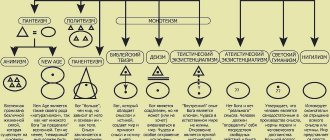Updated September 28: 57,632 Author: Dmitry Petrov
Hello, dear readers of the KtoNaNovenkogo.ru blog. In modern political science, it is customary to distinguish three political regimes: totalitarianism (what is it?), democracy (what is it like?) and authoritarianism.
The latter belongs to the category of non-democratic, characterized by a strong-arm management style and a limited number of citizens’ freedoms.
Society has an ambiguous attitude towards this regime - some criticize it for the presence of many restrictions, others praise it for the order.
Let's take a closer look at its signs and characteristics in order to draw our own conclusions about authoritarianism.
What is AUTHORITARISM - definition, meaning in simple words.
In simple words, Authoritarianism (Authoritarian regime) is a theory and system of government, usually associated with dictatorship, as opposed to democracy, that arose in response to state crises of the political system (democratic failure, social polarization, economic stagnation and international instability).
For almost all of human existence, authoritarian forms of government have existed. An authoritarian regime exercises sovereign power through one-party rule and may depend on the military to maintain order. In its extreme control over society, it can become a totalitarian monopoly.
It is a principle based on submission to authority and is opposed to people's autonomy in thought and action. As a form of government, authoritarianism concentrates power in the hands of
- leader (cult of personality)
or
- a small elite (elite dictatorship), which is constitutionally not accountable to the people.
Unlike totalitarian systems, authoritarian governments usually lack a highly developed ideology. Leaders of authoritarian systems often exercise their power arbitrarily and consider themselves above the existing law. Modern authoritarian systems typically operate through single dominant parties that control the government and other key parts of society, including the economy, the media, and education. They usually do not hold free elections that could replace them with a rival party. It is difficult or impossible for citizens to form opposition groups or parties.
Origin of the term "authoritarianism"
The term “authoritarianism” was introduced into scientific practice by specialists of the Frankfurt School.
Initially, this concept meant the presence of social properties characteristic of mass consciousness and political culture.
Authoritarianism reflects the political structure of a state in which citizens strictly obey it and its rule.
In addition, authoritarianism can be defined as a personality trait or social attitude that reflects the belief in the need to follow authority, be loyal to it, and obey in everything.
Thus, authoritarianism presupposes mandatory, strict obedience to the leader. Authoritarianism, as a political regime, is based on the principles of authoritarianism, i.e. exclusion of the democratic orientation of the social structure. An authoritarian political regime, at its core, is a dictatorship of an individual or a group of oligarchs.
Authoritarianism and democracy.
The term "authoritarian regimes" in its broadest sense covers all forms of non-democratic government. Compared to democracies, authoritarian regimes do not support
- institutions and participation procedures,
- political competition,
- fundamental rights and control of power (separation of powers, parliaments, elections, plurality of parties, etc.) characteristic of democracy, and thus lacks democratic legitimacy.
Signs of authoritarianism.
Juan Linz, whose 1964 description of authoritarianism is influential, characterized authoritarian regimes as political systems by the following qualities:
- “limited rather than responsible political pluralism” in contrast to the fundamentally unlimited pluralism of democracies; that is, restrictions on political institutions and groups (such as legislatures, political parties and interest groups),
- lack of “intensive or extensive political mobilization” and restrictions on the mass public (for example, repressive tactics against opponents and prohibition of anti-regime activities),
- "formally vague" executive power, often changeable or vague.
Features of an authoritarian political regime
Below are the main signs and characteristics of an authoritarian regime:
- With such a policy, there is a total concentration of power in the hands of one strong leader or several closely related state bodies. Moreover, at the same time, the people are alienated from the real levers of power.
- The principle of separation of powers is limited and, in principle, ignored. Very often, the president and executive structures subordinate all other government bodies to themselves, and as a result, are endowed with judicial and legislative powers.
- In other cases, the court acts as an auxiliary institution and various extrajudicial bodies can be used along with it.
- Representative bodies of government may be present in such a regime, although their role in this case is significantly limited.
- The system of operation of the principles of election of government bodies, control and accountability to their population is minimized or absent.
- The administrative and command method act as the main methods of government, but there is no mass terror.
- Various power structures (military, police) are beyond the control of society and are often used for purely political purposes.
- The freedoms and rights of man and citizen are not really ensured, although they are proclaimed. At the same time, “semi-glasnost” and complete censorship are preserved; private pluralism is allowed by the authorities.
Do you need help from a teacher? Describe the task - and our experts will help you!
Types of authoritarian rule.
Linz identifies seven types of authoritarian rule:
- Bureaucratic-military management.
- Authoritarian corporatism.
- Mobilizing authoritarian regime.
- Post-colonial authoritarian regime.
- Racial and ethnic "democracies".
- Incomplete totalitarian and pre-totalitarian regime.
- Post-totalitarian authoritarian regime.
Types of authoritarian governments also include:
- absolute monarchy
- military dictatorship
- ideological regimes.
Examples of an authoritarian regime
- Iran (with its theocratic regime);
- Mexico with its bureaucratic authoritarianism. That is, in this country, power is in the hands of bureaucrats;
- Argentina, where in the 60s and 70s of the 20th century there was also bureaucratic authoritarianism;
- Dominican Republic in the early 20th century (under the dictatorship of Rafael Trujillo from 1930 to 1961);
- Saudi Arabia (with its absolute monarchy);
- Iraq (dictatorship of Sadam Hussein from 1979 to 2003);
- Portugal under dictator António Salazar (1932–1968);
- USSR after 1953 (after the totalitarianism of Joseph Stalin);
- Military dictatorship in Brazil from 1964 to 1985.
Forms of authoritarian management.
Typically, authoritarian governance takes the following forms:
Authoritarian monarchy
The most traditional political system in the modern world is an authoritarian monarchy. The basis of its legitimacy is common and often associated with mythical assumptions regarding the founding of the dynasty in question. Examples of this type are Ethiopia (before 1974) and Saudi Arabia. Accession to the throne is usually governed by heredity, and there is little or no open political competition. There is no formal separation of powers, and power structures are personalistic and reinforced by the aristocratic ideology of the upper class. In earlier times, most such regimes were built on feudal agrarian structures. Today they tend to have centralized and absolutist characteristics.
"Old" oligarchy
This type of authoritarianism is prevalent in Latin America. This is a traditional authoritarian regime. Such a regime receives support from feudal or "neo-feudal" rural structures and, since the late twentieth century, from sections of the urban upper class. In extreme forms of the old oligarchy (such as Nicaragua before 1979), a small number of leading families exercise almost exclusive control over the political and economic life of the country. In this system, one leader can be replaced relatively easily by another, sometimes through rigged elections that do not fundamentally change the power structure. Political activities and the media are usually controlled by the regime's repressive apparatus. Other elements that make up the separation of powers, such as an independent judiciary or a federal structure, are also missing.
"New" oligarchy
The "new" oligarchy receives support from dominant urban groups in the modern context. In this “hegemonic” regime, there is no open competition for government positions. Usually there is a one-party structure, which, however, is predominantly formal and ineffective. Instead, much emphasis is placed on bureaucracy. Public opinion and the media are controlled, and leadership is centralized and highly personalized. There may be some charismatic elements of legitimacy in this regard. Compliance is established either by passive acceptance or by repressive measures. Both social base and “inclusiveness” vary along ethnic and class lines. In most cases, a relatively broad ethnic base is combined with more limited class interests that favor the advantaged groups of society. Examples include countries such as Cameroon, Tunisia and the Philippines (under Ferdinand Marcos; 1917–1989).
Semi-competitive authoritarianism
In Latin America, this system was also based on traditionally dominant classes, but there is a greater balance between rural and urban elements. Opposing elements are often institutionalized in "conservative" and "liberal" parties, for example in nineteenth-century Chile, Colombia or Uruguay. Active participation remains limited to the middle and upper strata of the population. Semi-competitive regimes tend to follow established constitutional rules within a presidential or parliamentary system. Regular transfers of power occur within established limits. As a rule, they are less repressive than “oligarchic” systems. The media also often enjoy greater freedom.
Socialist authoritarianism
“Socialist” regimes reveal a different pattern. They are characterized by an effective one-party organization, a centralized system of government, and an ideology aimed at social order and “non-capitalist” and “self-reliant” development. Freedom of expression and pluralistic forms of organization are restricted. However, there are many variations. One group (such as post-independence Tanzania and Guinea) attempted to base their specific type of socialism on the traditions and culture of their societies. Another group (e.g. Algeria, Mozambique) championed a Marxist-oriented “scientific” brand of socialism. In both groups there may be some semi-competitive elements in the internal party and parliamentary spheres. Socialist regimes should be distinguished from their totalitarian "communist" counterparts, if only because of their overall "underdevelopment" and relative lack of effective social control.
Military regimes
In addition to civilian regimes, there are systems that are controlled by military rulers who came to power through a coup d'état after previous civilian institutions failed. In the absence of significant countervailing forces, the military's monopoly on physical coercion makes less effective civilian governments easy prey for armed groups. The social foundations of these regimes are usually quite narrow. Some military rulers act as temporary caretakers and make sincere attempts to return their countries to civilian rule (like Olusegun Obasanjo in Nigeria in 1980). Others, on the contrary, seek to establish their power forever.
Three subtypes of military authoritarian regimes can be distinguished:
- personal military authoritarianism (centered around the “strong man” and his closest followers);
- corporate military authoritarianism (there is a certain institutionalized transfer of power established within the leadership ranks of the armed forces);
- military socialist authoritarianism (establishes its power on a permanent basis by creating a one-party system).
Features of an authoritarian political regime
An authoritarian regime is characterized by the following features:
- the power of the elite or head of state is not limited by law;
- the people do not take part in governing the state and cannot control the activities of the ruling elite or the head of state;
- the existence of a multi-party system is allowed, but opposition parties are prohibited;
- The government takes an active part only in those areas of public life that are closely related to politics. Economy, science, culture, private life are not subject to control;
- the priority of state interests over personal interests is established;
- repressive measures are applied only to open opponents of the system.
Thus, authoritarianism is a softer political regime compared to totalitarianism. This is especially clear in relation to government and society. These relations are being built along a more liberal path, and a clearly developed labor ideology is being abolished. However, in relation to society, the authorities use methods based more on coercion than on persuasion.
Historically, the authoritarian regime has been assigned the appearance of a system of strict political rule, which constantly uses coercive and forceful methods of regulating basic social processes. Therefore, the main political institutions in society are the army, police and other special services.
Thus, under authoritarianism, all connections with society are blocked, and the opportunity to use the support of the population to strengthen the ruling elite is lost.
Consequently, the government, which, first of all, relies on a narrow circle of the ruling stratum, does not receive support from the population and its position becomes precarious.
In such conditions, the authoritarian regime is transformed into a totalitarian or democratic regime, depending on what political instruments it is guided by.
What is an authoritarian government?
An authoritarian government is a government that wields power and carries out policies without the consent of the people it rules.
It is not elected by the people and has absolute power to rule as it pleases without consulting the people it rules. This may be a government in which one person acts as an absolute ruler, or a government consisting of a specific group of people, such as a political party. Authoritarian governments are typically characterized by suppression of dissent and control of the flow of information. All media are subject to strict censorship. In many cases, the media is used as a tool of an authoritarian government to make it and its policies appear more popular in the eyes of the general population.
Authoritarian governments can come to power by force of arms, as the anointed successors of previous authoritarian regimes, or even through democratic means.
The main reasons for the prevalence of authoritarian regimes in modern societies
Note 1
Authoritarian rule is also characteristic of the modern stage of social development. It is not always fully present. Sometimes, the political regime in a country is supplemented with elements of authoritarianism.
The existence of authoritarianism in modern society is explained by the following reasons:
- Orientation of the population towards Domostroevsky concepts, which involve relying on the state and its “strong leaders”;
- The structure of society adheres to old, traditional forms of organization, so the presence of authority is its basis; stable patriarchal type of political culture;
- The development of society, especially its socio-economic sphere, is at a slow pace. Scientific progress is also not observed, which leads to backwardness of education;
- Exposure to the faith and religious teachings of the majority of the population of the state. This leads to the direction of the political views of citizens in a certain direction. The church is used as an institution to influence the consciousness of citizens and protect the existing political regime;
- Society is in a stage of development, so social tension is quite strong and pronounced.
Authoritarianism and totalitarianism: differences.
Totalitarianism is authoritarianism, but it goes beyond it. In an authoritarian system, there are few social and economic institutions outside the control of the government.
- An authoritarian system wants full political power, but does not go beyond that.
- A totalitarian system of government wants power over everything and everyone.
Representatives of totalitarian regimes seek power outside of government and begin to invade the personal life and ideology of everyone under their power.
One of the most famous examples of a totalitarian ruler was Adolf Hitler. He went beyond political rule and sought control over what people believed and even what race he thought people should be. Another key difference is how they execute their decision. An authoritarian ruler is more focused on individual power, while a totalitarian ruler is more of a charming ideologue who claims to be guided by the interests of the people or the state.
The difference between authoritarianism and totalitarianism
| Authoritarianism | Totalitarianism |
| The authorities are only interested in political life and the defense of the country. | The government controls not only politics, but also the economy, public and private life. |
| The authorities do not exercise special control over the political worldview of citizens. The authorities simply deprive them of political rights and, consequently, the opportunity to participate in the life of the state. | Always is political ideology. This is an attempt by power to influence what and how people think. Under totalitarianism, there is propaganda of some political idea. In the USSR this idea was communism, in Germany under Hitler it was Nazism. |
| The authorities may not have a particular opinion about the dominant nation or race in the country. The emphasis is on politics . | People or entire nations may be declared objectionable. They are persecuted and subjected to political repression. That is, punishment carried out on the orders of the leader of the country. |
| The personality cult of the state leader does not play a special role. The leader may not have outstanding charisma. He is not glorified or exalted. |
Read more about the Totalitarian regime.
Authoritarianism today.
Authoritarianism and populism became widely used terms when the likes of Trump, Duterte, Erdogan and Modi came to power. There are fears everywhere that we are entering a new authoritarian and populist era. The Brazilian Committee of the World Social Forum stated in August 2021, for example, that “the rise of reactionary and authoritarian thought in Brazil, in Latin America and throughout the world puts all of us, the proponents of the new world, in a framework of solidarity. Social justice, democracy and peace are in a state of readiness and constant mobilization and require a process of articulation and worldwide unity of social movements.” Research conducted by CIVICUS earlier in 2021 found that only 3% of the world's population lives in countries where the rights to protest, organize and speak out are respected, protected and fulfilled. Even the World Economic Forum believes that we are “entering a period that is easily recognizable as pre-authoritarian and fascist.”
Countries with authoritarian government regimes.
Based on the electoral process and pluralism, the functioning of government, political participation, political culture, and civil liberties, the most authoritarian regimes in the world today are:
- North Korea
- Syria
- Chad
- Central African Republic
- Democratic Republic of the Congo
- Turkmenistan
- Equatorial Guinea
- Tajikistan
- Saudi Arabia
- Uzbekistan
- Guinea-Bissau
- Yemen
- Sudan
- Libya
- Burundi
- Laos
- Eritrea
- Iran
- Afghanistan
- Azerbaijan
- United Arab Emirates
- Bahrain
- Djibouti
- Swaziland
- Oman
- Togo
- Kazakhstan
- Vietnam
- China
- Belarus
Authoritarianism
Authoritarianism is a form of state power that is based on the unconditional or imaginary authority (see Authority) of the ruling subject (ruler, leader, political leader, group, organization) and is determined by the corresponding form of political consciousness based on the attitude to authority in general and to the authority of power in in particular. Authoritarian power is based on the traditional, rational or irrational, charismatic authority of the bearer (or bearers) of power, his ability to retain power and attract supporters. As a rule, this subject has broad or exclusive, and sometimes unlimited powers, acting as the head of state as the main bearer of the sovereignty of the supreme power. A political regime corresponding to the principles of authoritarianism significantly limits or completely excludes the institutions of representative and electoral democracy, political freedoms and civil participation in matters of government. Authoritarianism is often combined with the dictatorship of an individual (or a group, for example, a partyocracy or an oligarchy), which in some cases is transformed into the most pronounced form of authoritarian power - autocracy, in which the highest state power belongs to one subject (see Autocracy).The general features of all political regimes corresponding to the principles of authoritarianism boil down to the following:
- Autocracy (autocracy), that is, the concentration of supreme state power in the hands of one person or group of persons (traditional absolutist monarchies in a number of countries of the Arab East, lifelong presidency in a number of African countries, military juntas and oligarchic regimes in a number of Latin American countries, former communist partocracies in several countries in Eastern Europe).
- Monopolization of the highest state power, along with the implementation of policies that exclude political competition, real opposition and the autonomy of various political systems, as representing a probable or real threat to such monopolization.
- Restriction or imitation of democratic institutions and procedures; Moreover, the recruitment of the political elite is carried out through co-optation or appointment from above, and not through free elections.
- Limitation of the principle of separation of powers, in which there is a pronounced dominance of the executive authorities, along with a reduction in the role of representative bodies and their replacement by authoritarian-bureaucratic institutions, as well as the lack of control and unaccountability of the highest government authorities to civil society.
- Reliance of the highest state power primarily on command, administrative and force methods, emphasis on coercion; At the same time, pronounced force methods (repression) are irregular in nature and are used, as a rule, only when necessary (for example, to neutralize political opponents or suppress mass discontent).
- Limited government intervention in public life; government intervention operates, as a rule, only in the political sphere and public administration, without spreading (or partially spreading) into extra-political spheres.
- Lack of guarantees for the security of an individual in relations with the authorities; At the same time, individual rights and freedoms may be proclaimed, but not actually ensured.
The term “authoritarianism” was introduced into scientific circulation by theorists of the Frankfurt School to characterize a special type of consciousness, marked by commitment to authority, which is inherent in both political culture and mass consciousness in general. In the work of T. Adorno and his colleagues “The Authoritarian Personality” (1950), designed to empirically substantiate this concept, the concept of authoritarianism is revealed using a socio-psychological analysis of the corresponding type of personality (authoritarian personality). According to their concept, it was the authoritarian consciousness, which is characterized by such value systems as uncriticality and stereotyped thinking, reliance on authorities, the cult of power and obedience, fear of freedom and responsibility, that created the social soil and breeding ground for all “fascist”, “fascist” and the like political regimes in the 20th century (subsequently, however, a point of view prevailed based on the distinction between authoritarian and totalitarian types of consciousness, which is associated with the emergence of fascist tendencies in the 20th century - see Totalitarianism). In the 1960s, this theory of authoritarianism was widely used in left-wing sociology and critical journalism, but since the mid-1970s it has been subject to sociological criticism (especially by representatives of the neoconservative orientation). Many modern researchers, recognizing that the concept of authoritarianism was once an important element of the theoretical constructions of the social sciences, draw attention to the need to be careful when using it, especially in empirical research.
In political philosophy, authoritarianism is considered from the point of view not so much of authoritarian consciousness, but of authoritarian ideology, defined as a specific form of the ideology of order, originating from the ideology of the Restoration of the early 19th century (J. de Place, L. de Bonald, R. de la Tour du Pin ) with its romantic cult of the historical past, national heroes, with a developed political mythology, with an emphasis on the decisive role of power, state and obedience. T. Hobbes is often considered a theorist of authoritarianism, as an ideologist of strong state power capable of establishing order and curbing the anarchy of unlimited freedom. Among other prominent theorists of the authoritarian type of government are: J. D. Cortes, an opponent of liberalism and socialism, a supporter of the religious-absolutist model; F. Yu. Shal - theorist of the monarchical version of authoritarianism; G. Treitschke is an ideologist and theorist of Bismarck’s imperial rule. Historical forms of authoritarian ideology changed from reactionary to conservative, then to liberal, later they were replenished with nationalist, pro-fascist and fascist variants. In the second half of the 20th century, crises of individual national states gave rise to new authoritarian regimes of a mixed type, which largely lost their ideological component.
Nowadays, in Western political science, the most common point of view is that authoritarian rule usually prevails in communities where either political and legal institutions are not developed, or accelerated implementation of socio-economic transformations is required in the conditions of the majority of society being unprepared for them, the society itself is strictly stratified, and Democratic institutions tend to be weak and unstable. At the same time, researchers most often explain the long existence of numerous regimes of this type in African countries by the underdevelopment of political culture and social institutions, and in Asian countries by the peculiarities of national culture and centuries-old political traditions. Thus, Confucian states (China, South Korea, Vietnam, Singapore) are characterized by the cult of a centralized state and a traditionally strong authoritarian-bureaucratic apparatus, developed paternalistic relations (guardianship “from above” with complete subordination “from below”) and general discipline of the population. Muslim states (countries of the Arab East, Iran, Indonesia, Malaysia) are characterized by the cult of supreme power, the recognition of its virtually unlimited right to intervene in private and public life, the established belief that only the strong (ideally unlimited and undivided) and based primarily By force, power is capable of ensuring social order. Along with this, in the countries of the Islamic world a unique authoritarian-collectivist concept of democracy has developed: thus, after a completely democratic election of a leader in the Muslim community (ummah), he receives practically unlimited [dictatorial] power into his hands, and this is perceived as the norm; Subsequently, this principle of government is approved throughout the entire state. For these reasons, many modern Confucian and Muslim states, having combined advanced industrial technologies with the traditions of national culture, have actually adopted an authoritarian model. At the same time, what is perceived in Western societies as dictatorship and arbitrariness may look in the eyes of their population as “the rule of the best and worthy,” and arbitrary interference in the private sphere and violations of civil rights - as fair punishment of people who violate moral, religious or other norms that are unconditionally accepted in these societies. Therefore, today, in general, although with reservations, it is recognized that such values as free market economics, human rights, the principles of separation of powers and the rule of law are products of Western civilization and its political culture, and their implementation on non-European cultural soil is very difficult.
"Competitive authoritarianism"
“Competitive authoritarianism” is defined as the emergence of a new form of hybrid regimes. It can be argued that these regimes are "lesser forms" of authoritarianism in that they rely on formal democratic institutions as a means of obtaining and exercising political power, but they still violate the basic principles of democracy. Elections in countries with "competitive authoritarianism" are held regularly and are largely free of widespread fraud, but the regime still has the power to abuse resources, control the media, and illegally intimidate its opposition.
Such regimes may be more successful in the long term by preventing highly publicized rights violations from international news outlets. In this way, an authoritarian regime or dictatorship can avoid widespread domestic protest or even international rejection.
Examples of such authoritarian regimes are the countries of the Middle East and, to some extent, North Africa. These are the only regions in the world that are still ruled by single monarchs today. In the Arab world, monarchs rule in more than a third of Arab League countries, including Morocco, Saudi Arabia, Jordan, the Sultan of Oman, Kuwait, Bahrain, Qatar and the United Arab Emirates.
All the Arab monarchs taken together rule over about forty million subjects. The question remains why and how these regimes remain so resistant to democratization. While the number of electoral democracies has nearly doubled worldwide since 1972, their numbers in the Middle East and North Africa have declined significantly.
Michael L. Ross, a professor of political science at the University of California, Los Angeles, argues that oil may be why Middle Eastern authoritarian regimes are so resilient. The Middle East is undoubtedly one of the most oil-rich regions, and its wealth of resources may be an explanation for the fact that most states have not democratized in this region. But not all authoritarian states have oil resources, so while oil wealth may explain the presence of authoritarianism in the Middle East, it should not be assumed that this is the case everywhere. The Middle East is a striking example of a region consisting of states that, despite all the waves of democratization, managed to maintain stable authoritarian regimes. Although such persistence may have different causal mechanisms depending on the country in question, general trends in oil wealth and the presence of coercion tend to explain high levels of autocratic rule.
In the personal sphere
The authoritarian approach is used not only in the business sphere, but also in education, and even in communication. This type of communication and upbringing has the same characteristics as authoritarian pressure in the work environment. Characteristics:
- All decisions are made individually.
- Rejection of the child as a person.
- Rigidity, pressure.
- The “carrot and stick” method.
- Coercion without explanation.
- Severe penalties for disobedience.
- Inability to seek compromise.
- Reluctance to listen.
- Indifference to other people's emotions.
Of course, such a parent, relative, spouse is not just a tyrant who wants those around him to suffer. The authoritarian style of communication has its reasons, which may lie in the fear of loneliness, in childhood traumas, in a painful desire for respect, recognition, in self-doubt. The person is convinced that his methods will lead to good results, that he is a fair and strict teacher, and all other methods are connivance and will lead to disaster.
Parents who use an authoritarian parenting style tightly control their child, invading all areas of his personal life and making decisions for him - who to be friends with, where to go for walks and what to do in his free time. They don’t bother explaining why the child is being punished or why he should perform this or that action, but simply argue: “because I said so,” or “I know what’s right.”
As a result, the child’s ability to analyze and think may simply atrophy, his intellectual abilities will become dull, he will simply stop asking questions, and his academic success will decline year after year.
We recommend: How to learn to show your love to a child?
Parents who practice authoritarian parenting are extremely demanding of their child, but instead of stimulating him, they use methods of threats, psychological pressure, punishment and coercion. A child must certainly earn toys or beautiful things through hard work and great achievements, but they are not given just like that, out of parental love.
A child who is subject to authoritarian pressure is completely deprived of his own opinion, initiative, or the right to make decisions. All decisions are made for him, and he simply has no right to any desires.
If the authoritarian style of family education has its advantages, then only in moderation, and only in early childhood, when the child is not yet able to walk, talk, make decisions and express himself independently, in other words, until he reaches four or five years of age. age. But in this case, the parents, making all decisions for the child, protect him and take care of him, and this is not an authoritarian approach, but a healthy, normal upbringing.











